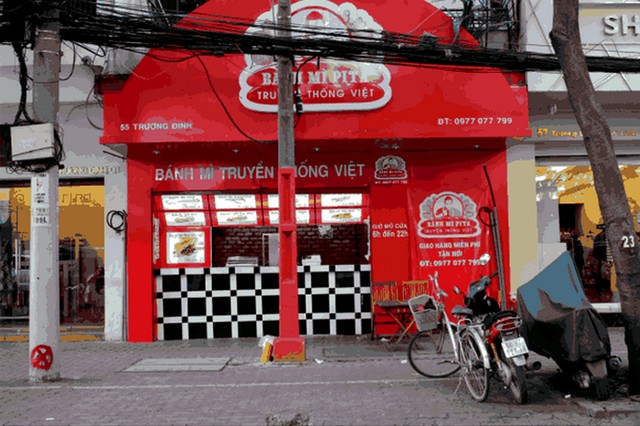|
Vietnamese firms
absent from food-chain market?
The fast food
market has formed in

A
Vietnamese banh mi store in
The invisible war
Fast-food chains seem to be not
affected by economic downturn in
The second factor contributing to the
attractiveness of the fast food market is that food is one of the four basic
needs of humans (food-drinks-accommodations-traveling). The industries
satisfying these requirements seem to be less affected by economic recession.
In addition, the gloomy real estate market in
This market is attractive but is it
fully pink or not? That question is a difficult problem for food chain
businesses. The first challenge comes from the “motorbike culture” in
Overall, we can say that all the
cities in
Competition in the food chains can be
understood as the invisible war between modern food chains and hundreds of
thousands of family-sized food shops in
The second thing is the price.
Currently, it is for sure that the Vietnam Food & Beverages Service
Company (VFBS) of the Imex Pan Pacific Group is confronted with this problem
when its two fast-food brands Burger King and Domino Pizza have to compete
with KFC, Pizza Hut, Lotteria, Jollibee and others.
The third factor affecting the
expansion of fast food chains is the scarcity of good retailing spaces in the
key areas.
The major players in the fast food
market are mainly foreign corporations which have a lot of experience in the
industry. In this market, Vietnamese firms are in a disadvantageous position
owing to their short-term thinking and unprofessionalism in operating a food
chain. Pho 24 and Highland Café are being sold to foreign companies.
In fact, several domestic brands have
gained a solid foothold, such as Trung Nguyen coffee chain and Sushi Bar in
Overall, it is the long-term
strategic thinking of the CEO.
How to win at home?
The food chain playground is for the
players with long-term vision and power. Related to Starbucks, the opening of
a few shops is just for market exploration and assessment. The come of major
brands only indicates that the
The Swensen ice cream brand has been
in
To compete with foreign brands,
Vietnamese players need to neglect short-term benefits.
As noted above, the international
players are still cautious in development and they are still assessing the
Vietnamese market. Thus, the opportunity for local fast-food brands is still
a lot.
To compete with foreign brands,
Vietnamese firms should note two important points: The first important point
is the vision and long-term power. Building a food chain is building a
system. The short-term thinking and the goal for short-term benefit will not
reap success.
The second important factor is to
develop the concept and idea.
In operation, local investors must
thoroughly adhere and preserve the idea and concept of their stores. The
lessons from Givral when the two brands of Givral and Trang Tien ice cream
are owned by the same firm - Ocean Hospitality is worthy. The development of
the high-end brand of Givral and the popular brand Trang Tien ice cream in
the same store chain is like putting luxury suits together with T-shirts and
shorts.
Customers will be confused because
the well-to-do customers will feel that Givral products are trivialized while
popular customers will feel very afraid when going into a luxury store just
to buy some ice cream.
The second lesson comes from Kinh Do
stores when customers cannot understand these stores are selling moon-cakes,
cookies, fresh-cream cake sale or coffee? No idea, no concept and at the same
time selling too many products and services in a chain of stores is the
fastest way for making self-made difficulties in operating food chains.
Jollibee is a brand of the
The common weakness of famous
fast-food brands in the world is that they must maintain uniformity in many
countries, leading to less flexibility.
Local brands can take advantage of
this to develop when large international players have not shaped the market
taste. It is difficult for international brands to adjust ideas and concepts
to suit the culture of
Starbucks is a typical example when
Vietnamese food chains can still compete well with this famous brand.
Whether CEOs of Vietnamese food
chains can overcome themselves to be successful in the home market like
Jollibee did in the
S. Tung,
|
Chủ Nhật, 24 tháng 11, 2013
Đăng ký:
Đăng Nhận xét (Atom)
Không có nhận xét nào:
Đăng nhận xét